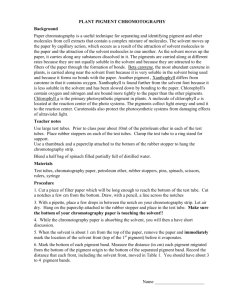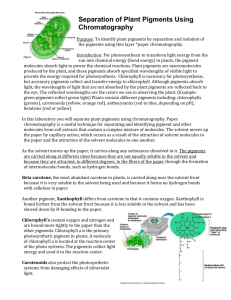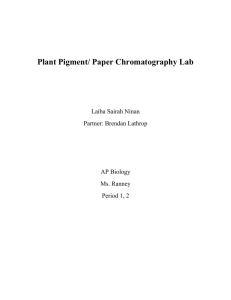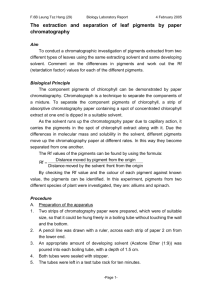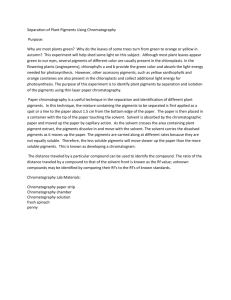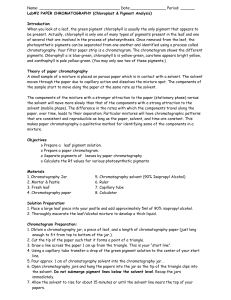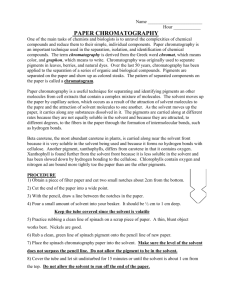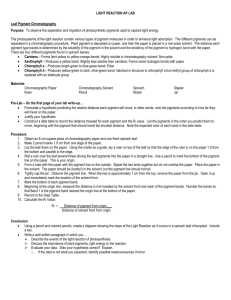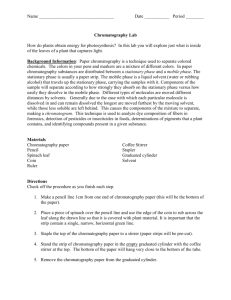chromatography lab - Tamalpais Union High School District
advertisement
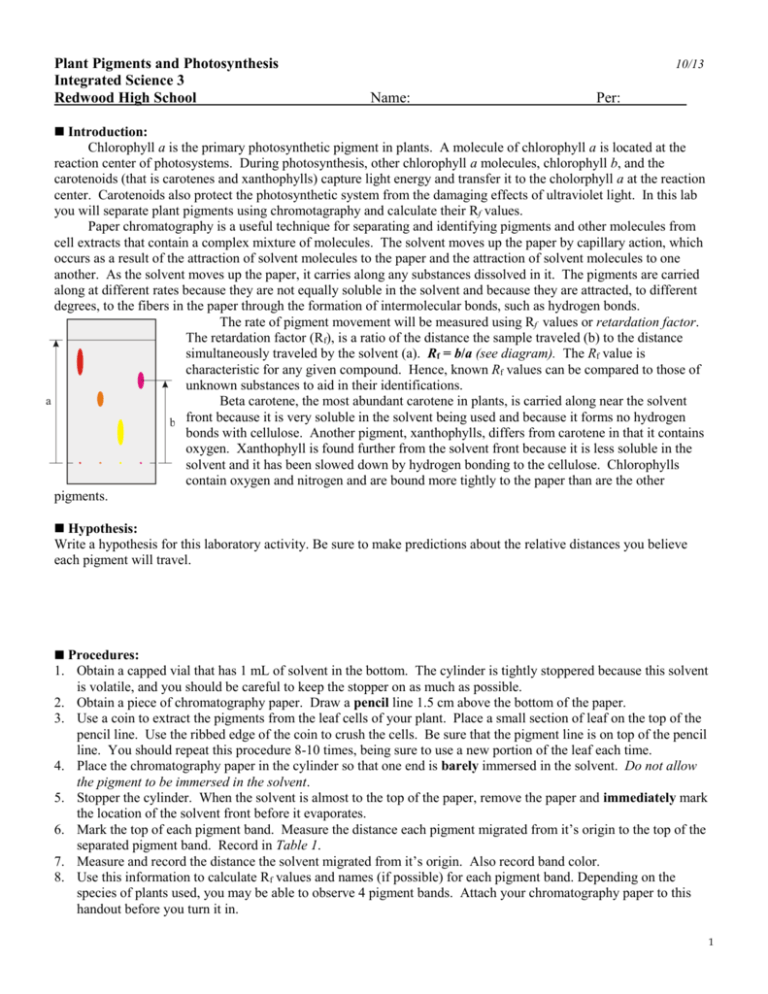
Plant Pigments and Photosynthesis Integrated Science 3 Redwood High School 10/13 Name: Per: Introduction: Chlorophyll a is the primary photosynthetic pigment in plants. A molecule of chlorophyll a is located at the reaction center of photosystems. During photosynthesis, other chlorophyll a molecules, chlorophyll b, and the carotenoids (that is carotenes and xanthophylls) capture light energy and transfer it to the cholorphyll a at the reaction center. Carotenoids also protect the photosynthetic system from the damaging effects of ultraviolet light. In this lab you will separate plant pigments using chromotagraphy and calculate their Rf values. Paper chromatography is a useful technique for separating and identifying pigments and other molecules from cell extracts that contain a complex mixture of molecules. The solvent moves up the paper by capillary action, which occurs as a result of the attraction of solvent molecules to the paper and the attraction of solvent molecules to one another. As the solvent moves up the paper, it carries along any substances dissolved in it. The pigments are carried along at different rates because they are not equally soluble in the solvent and because they are attracted, to different degrees, to the fibers in the paper through the formation of intermolecular bonds, such as hydrogen bonds. The rate of pigment movement will be measured using Rf values or retardation factor. The retardation factor (Rf), is a ratio of the distance the sample traveled (b) to the distance simultaneously traveled by the solvent (a). Rf = b/a (see diagram). The Rf value is characteristic for any given compound. Hence, known Rf values can be compared to those of unknown substances to aid in their identifications. Beta carotene, the most abundant carotene in plants, is carried along near the solvent front because it is very soluble in the solvent being used and because it forms no hydrogen bonds with cellulose. Another pigment, xanthophylls, differs from carotene in that it contains oxygen. Xanthophyll is found further from the solvent front because it is less soluble in the solvent and it has been slowed down by hydrogen bonding to the cellulose. Chlorophylls contain oxygen and nitrogen and are bound more tightly to the paper than are the other pigments. Hypothesis: Write a hypothesis for this laboratory activity. Be sure to make predictions about the relative distances you believe each pigment will travel. Procedures: 1. Obtain a capped vial that has 1 mL of solvent in the bottom. The cylinder is tightly stoppered because this solvent is volatile, and you should be careful to keep the stopper on as much as possible. 2. Obtain a piece of chromatography paper. Draw a pencil line 1.5 cm above the bottom of the paper. 3. Use a coin to extract the pigments from the leaf cells of your plant. Place a small section of leaf on the top of the pencil line. Use the ribbed edge of the coin to crush the cells. Be sure that the pigment line is on top of the pencil line. You should repeat this procedure 8-10 times, being sure to use a new portion of the leaf each time. 4. Place the chromatography paper in the cylinder so that one end is barely immersed in the solvent. Do not allow the pigment to be immersed in the solvent. 5. Stopper the cylinder. When the solvent is almost to the top of the paper, remove the paper and immediately mark the location of the solvent front before it evaporates. 6. Mark the top of each pigment band. Measure the distance each pigment migrated from it’s origin to the top of the separated pigment band. Record in Table 1. 7. Measure and record the distance the solvent migrated from it’s origin. Also record band color. 8. Use this information to calculate Rf values and names (if possible) for each pigment band. Depending on the species of plants used, you may be able to observe 4 pigment bands. Attach your chromatography paper to this handout before you turn it in. 1 Data and Analysis: Tape Chrom Paper Here Plant name: Band Color Dist. (mm) Rf (show work using formula below) Pigment name (use colors or Rf values below) 1. 2. 3. 4. Solvent 1 Rf formula: Rf = distance pigment migrated (mm) distance solvent front migrated (mm) Known pigments values (may be provided by teacher): 0.97 = Rf for Carotene (yellow-orange) 0.51 = Rf for Xanthophyll (yellow) 0.24 = Rf for Chlorophyll a (bright green-blue green) 0.10 = Rf for Chlorophyll b (yellow green to olive green) Discussion: 1. What factors are involved in the separation of the pigments? 2. Would you expect the Rf values to be the same if a different solvent were used? Explain. 3. What is the function of chlorophyll and other plant pigments in the process of photosynthesis? 4. How does it benefit a plant to have multiple pigments? 5. Reflect on your hypothesis. Was is supported or refuted? Include data to support your answer. Extension: 1. Consider the role of plant pigments in photosynthesis, explain why some leaves change color in the fall. 2. How might differences in pigments among plants alter human carrying capacity? 2


